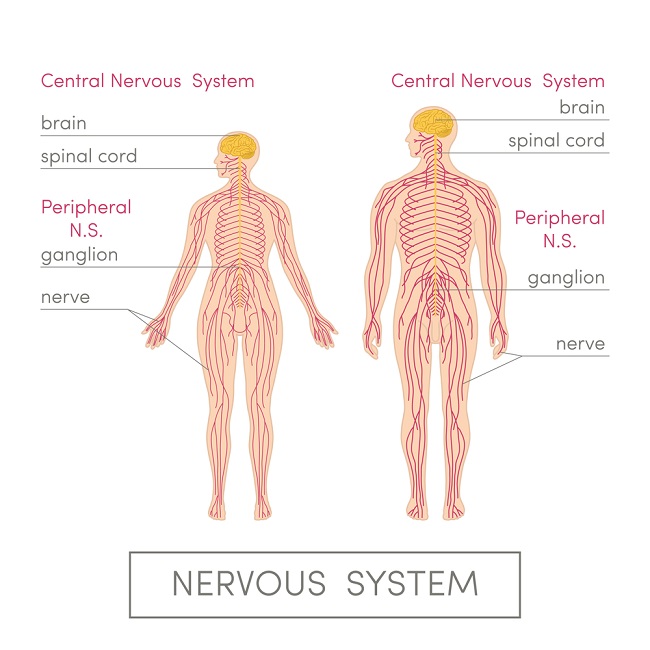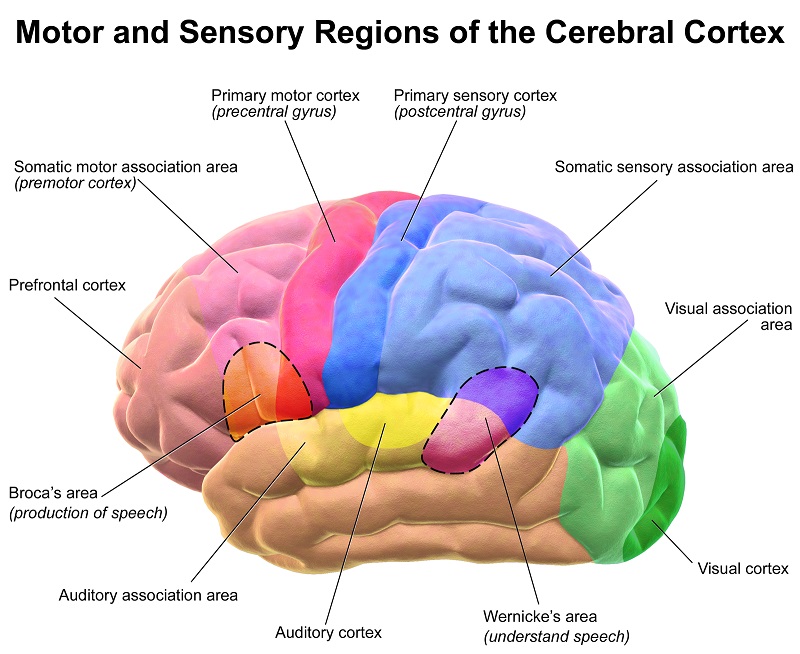Definition
The central nervous system (CNS) consists of the brain and spinal cord. This body system is responsible for integrating and coordinating the activities of the entire body. Through these physical structures, thought, emotion, and sensation are experienced, and body movements are coordinated.
Overview
The central nervous system can be thought of as the coordination and integration system within organisms. The CNS takes signals from the peripheral nervous system, processes them, then creates new signals to coordinate actions of different body systems. For instance, long-term and short-term metabolism and homeostasis are regulated through close interaction between the central nervous system and the endocrine system.
While the CNS is functionally made of neurons, other cell types such as glial cells play important supporting roles. Some cranial nerves, like the optic and olfactory nerves, are also considered to be a part of the central nervous system. All other nerves are part of the peripheral nervous system, but they still connect to the CNS. As such, the central nervous system is the coordinated processing center of the body.

Central Nervous System Function
Coordination and Movement
The primary function of the central nervous system is integration and coordination. The CNS receives input from a variety of different sources, and implements an appropriate response to the stimuli, in a cohesive manner. For instance, in order to walk the CNS needs visual and integumentary cues – the texture of the surface, its incline, the presence of obstacles, and so forth.
Based on these stimuli, the CNS alters skeletal muscle contraction. Once infants learn to walk, this happens involuntarily, no longer requiring conscious thought or concentration. A similar process of receiving complex stimuli and generating a coordinated response is required for vastly varied activities – whether it is balancing a bicycle, maintaining a conversation or mounting an immune response.
Thought and Processing
The CNS, especially the brain, is considered the physical seat for most higher-order mental functions. Neuronal connections form the basis for thought and retention of memory. The brain plays an important role in the development of speech, language, and communication. These tasks involve an association of abstract symbols and sounds with concrete objects and emotions. Motivation, ambition, reward, and satisfaction are also mediated through neuronal connections in the CNS.
At the same time, the limbic system of the brain also controls the most basic emotions and drives, such as pleasure, fear, anger, hunger, thirst, sleepiness and sexual desire. In addition, involuntary reflexes are mediated by the spinal cord, providing protection and quickly preventing injury.
The CNS directly or indirectly influences nearly every internal organ system, whether related to respiration, digestion, excretion, circulation or reproduction.
Central Nervous System Parts
In vertebrates, the brain and spinal cord are encased in bony cavities, with the brain residing within the skull, and the vertebral column protecting the spinal cord. Three membranous coverings, called the meninges, provide mechanical support and protection to the central nervous system. These meninges are called pia mater, arachnoid mater and dura mater. Pia mater is the layer closest to the nervous tissue and dura mater lies next to the bone.
Additionally, cerebrospinal fluid (CSF), produced in the four ventricular cavities of the brain, flows between the pia mater and arachnoid mater, providing protection from pathogens and mechanical support to the entire central nervous system. Special glial cells called ependymal cells produce CSF.
The Brain
The brain is made of the cerebrum, cerebellum, and brain stem. The cerebrum consists of two large hemispheres demarcated by a thick band of nerve fibers called the corpus callosum. Each of the hemispheres can be divided into four lobes. These are named the frontal, parietal, temporal and occipital lobes.
Each of these lobes is relatively distinct in function, relating to higher levels of cognition (frontal lobe), somatosensory input (parietal lobe), auditory stimuli (temporal lobe), or visual stimuli (occipital lobe). The localization of function to different lobes was initially discovered in patients with brain damage. Further study has indicated a high level of plasticity as well as communication and integration between neurons in different lobes.
The Cerebrum
The outer layer of the cerebrum is called the cerebral cortex and this is usually pinkish grey in color and contains neural cell bodies. It can be divided on the basis of function into sensory, motor and association areas as shown in the image below. For instance, the primary sensory cortex receives sensory input from the body as well as from specialized sense organs. The motor areas are involved in the control and execution of voluntary motor activities. Association areas are necessary for perception, abstract thinking, and associating new sensory input with memory.

These demarcations of the cerebral cortex are usually represented bilaterally in both hemispheres as seen in the image below.

The Cerebellum
The cerebellum is smaller than the cerebrum, is made of two lobes, and is located behind the brain stem. It is involved in the coordination of different muscle groups to produce smooth movement, controlling posture and balance. The neurons of the inner ear associated with balance relay their information to the cerebellum, which also receives auditory and visual input.
The Brainstem
The brainstem is made of three parts – the midbrain, pons, and the medulla oblongata. The medulla controls most involuntary actions, while the midbrain and pons are associated with sensory functions, excitation, and motivation. The brain stem connects the brain with the spinal cord.
The Spinal Cord
The spinal cord is about 17 inches in length, tapering along the length of the vertebral column in humans, beginning near the occipital bone and ending at the lumbar region of the spine. It connects the brain with most parts of the body while also containing independent neural networks for pattern generation and for executing reflexes.
It can be divided into 31 segments, each giving rise to a pair of spinal nerves. Spinal nerves carry both sensory and motor signals between the body and the spinal cord. The central part of the spinal cord consists of an H-shaped grey column containing the cell bodies of spinal cord neurons. The myelinated axons of these neurons form the white matter.
Example of Central Nervous System Activity
The key to the work of the CNS is integration. It receives input from various sources and creates a cohesive response. This is particularly important for animals in complex social structures, like human beings. For instance, meeting an old friend and catching up over coffee can seem like a relaxing event. However, to facilitate a successful interaction, the CNS needs to be abuzz with activity.
It begins when you see the friend and recognize her – your brain is correlating the neurochemical signals received from the optic nerve with the image you have in memory. It proceeds with the recollection of common experiences and the slipping into the vernacular of an earlier time.
Some research suggests that the CNS can even associate different body language with different sets of people or events. You may find yourself using phrases that haven’t been in your vocabulary for years or changing your accent and posture slightly, without being actively aware of it. The CNS retrieves a memory and correlates the memory with your current situation to generate an emotional and physiological response.
Central Nervous System Disease
Infection
The CNS can be attacked by pathogens – bacteria (bacterial meningitis), viruses (viral encephalitis), fungi (fungal meningitis, abscesses) or parasites (toxoplasmosis, cysticercosis). Alternatively, the CNS could be a secondary site for infection in advanced stages of illness from a different organ, as in tuberculosis or syphilis. The meninges covering the central nervous system are particularly susceptible to infection, especially when head trauma allows pathogens from other organs access to these delicate tissues, through the cerebrospinal fluid.
Lack of Blood Flow
The CNS is also particularly susceptible to changes in the vascular networks supplying critical nutrients, glucose, and oxygen. Blocks in blood vessels or burst capillaries can lead to strokes due to neuronal cell death. Depending on the location of the injury and the kind of medical attention received, the individual could suffer either loss of sensory, motor, cognitive or associative functions. Some people lose language abilities (aphasia), some lose memories while others may lose the full range of voluntary movements (paralysis).
Neurodegenerative Diseases
Ailments that lead to the accumulation of debris or unfolded proteins within cells of the body are particularly debilitating for the nervous system. Ailments like Alzheimer’s and Parkinson’s disease are progressive neurodegenerative disorders. The symptoms become more debilitating with age, and while there is a clear genetic factor involved in some of these ailments (Huntington’s disease) in most other neurodegenerative diseases, both genetic and environmental factors seem to be involved.
The cause for Alzheimer’s disease is still not known, though autopsies of patients who have suffered from the ailment often reveal protein plaques in the brain. There could be the involvement of neurotransmitter deficiency, aggregates of specific proteins, changes to the vascular structure of the brain, enlargement of brain ventricles and a shrinking of active tissue in the cerebral cortex.
Parkinson’s disease involves a progressive loss of motor ability, beginning from fine motor skills, and changes to posture and balance. Over time, all deliberate movements become difficult. The primary region of the brain affected by the disease is the substantia nigra, a region in the midbrain. As in Alzheimer’s, the definitive cause of Parkinson’s disease is not known.
Cancer
The CNS could also be affected by tumors and cancerous growths. The symptoms would depend on the location of the growth, size, malignancy, and the site of origin. Therefore they could lead to headaches, loss in cognitive ability, hearing loss, changes to motor control and autonomic functions. Tumorous growths could arise from different factors – exposure to ionizing radiation, carcinogenic environmental pollutants, retroviral infections, inherited genetic mutations or they could be idiopathic in origin, with no obvious causative agents.
Alcoholism and Addiction
Addiction is a disease of the brain in which the patterns of normal brain function are disrupted by the use of drugs or alcohol. For instance, a stimulant such as cocaine will increase blood flow and neurotransmitter release in the brain, giving it an exaggerated sense of wellbeing. Over time, the brain will become conditioned to expect these massive releases, and without the cocaine, the brain and body will experience withdrawals.
Alcohol is a depressant, meaning it slows body systems such as heart rate and breathing. Like any drug, alcohol changes the way the brain functions. Long-term alcoholics can have violent withdrawal symptoms because their brain and body have become accustomed to being severely depressed. Other depressants, such as heroin, create similar actions and also lead to severe addiction.
Quiz
